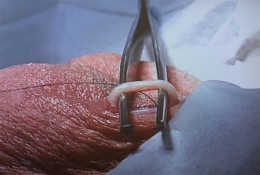Vasectomy – the surgery
What happens during this surgery?
We exclusively perform the vasectomy using the microsurgical Non-Scalpel Vasectomy (NSV) method. This technique does not involve the use of a scalpel, making the procedure less invasive and reducing recovery time.
The vasectomy procedure is straightforward and performed under local anesthesia, with the anesthetic solution injected locally in the scrotal area. Eating and drinking before the procedure are allowed. The patient should carefully shave the lower abdomen. Shortly before the operation, the skin is thoroughly disinfected, and the urologist administers several anesthetic injections in the groin area and scrotum. After a few minutes, the anesthesia takes effect, and the procedure can begin.
In the conventional method, the urologist makes a small incision, about 5-10 mm long, over the vas deferens. The vas deferens is exposed, and a 1-3 cm section is removed. The ends of the vas deferens are then electrically cauterized and sutured, thereby interrupting the sperm transport pathway. Finally, the skin is closed with tissue adhesive, and a sterile dressing is applied. The operation takes about 15 minutes per side, totaling approximately 30 minutes, and is nearly painless.

In rare cases, following the vasectomy, there may be hematoma, swelling of the scrotum growths or an infected wound. Here, high storage and cooling can lead to significant relief. Very rarely, postoperative bleeding might occur. For this reason, too, it is advisable to have the surgery performed by an experienced urologist .
Which complications and risks are there?
In rare cases, following the vasectomy, there may be hematoma, swelling of the scrotum growths or an infected wound. Here, high storage and cooling can lead to significant relief. Very rarely, postoperative bleeding might occur. For this reason, too, it is advisable to have the surgery performed by an experienced urologist.
After the vasectomy, there is an approx. 0.4% chance of a so-called „Reunification of the vas deferens“. The reason for this can be a tissue reaction.
What happens after the surgical intervention?
Some months after the vasectomy (up to12 weeks), the seminal fluid can still contain fertilizable sperm. That's why one should use an additional contraception method. Within the scope of an aftercare following the vasectomy, regular control examinations will be carried out during which the ejaculated semen is examined for fertilizable sperm (spermiogram). It is only once no more fertilizable sperm can be detected that no additional contraception method are required any longer and the operation is considered to have been successful. Mostly, three such control examinations will be performed after the vasectomy, in approx. 4-week intervals.
After approx. two 2 days, it will be possible for you to return to work. For approx. 2-3 days after the vasectomy, you may feel minor and drawing pain in the scrotum Nevertheless, in most cases, no complaints will appear. With expert execution by the urologist , postoperative bleeding or wound healing disorders are only very rare. On the day of the surgery, the patient must go easy on himself physically but will already be able to do some exercise after approx. 5-7 days.
Contact the Vasectomy Centre Berlin
You can get further information at the Vasectomy Centre Berlin.
Please make an appointment for an initial medical consultation and clarification conversation.
Phone: (030) 120 535 150
Fax: (030) 42 10 89 48
E-mail: info@berlin-vasektomie.de






